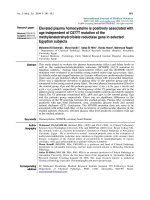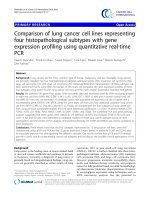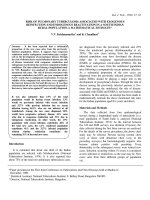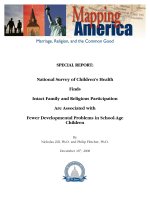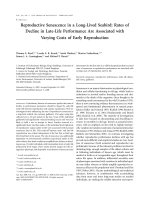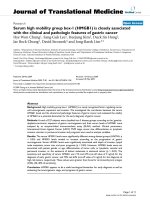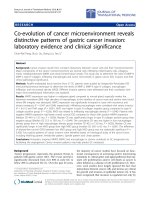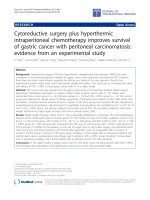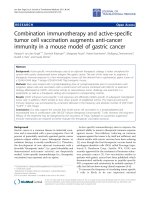Expression of long noncoding RNA GAS5 associated with clinic pathologic factors of gastric cancer
Bạn đang xem bản rút gọn của tài liệu. Xem và tải ngay bản đầy đủ của tài liệu tại đây (107.01 KB, 10 trang )
JOURNAL OF MEDICAL RESEARCH
EXPRESSION OF LONG NONCODING RNA GAS5 ASSOCIATED
WITH CLINIC PATHOLOGIC FACTORS OF GASTRIC CANCER
Nguyen Dang Bao1, Nguyen Trong Tue2, Tran Hieu Hoc3,
Nguyen Van Hung3, Tran Van Khanh2, Pham Duc Huan4, Ta Thanh Van2
1
General surgery Department, Gialai General Hospital, 2Center for Gene - Proteine Research,
Hanoi Medical University, 3Bach mai Hospital, 4Hanoi Medical University Hospital
Gastric cancer is the world’s third most common cause of cancer-related death. It remains difficult to cure,
particularly in less developed countries. Several recent studies revealed that long noncoding RNAs
(lncRNAs) could play a critical role in tumor biology. Dysregulation of lncRNA expression has been reported
in different types of cancers, including gastric cancer, but its role in gastric cancer remains unknown. This
study was designed to investigate the expression pattern, biological role and clinical significance of lncRNA
GAS5 in gastric cancer. LncRNA GAS5 was isolated from 48 cancer tissues and 48 non - cancer gastric
tissues of gastric cancer patients in Vietnam. LncRNA GAS5 levels were determined via quantitative reverse
-transcription polymerase chain reaction (Qrt - PCR) and normalized to the expression of GAPDH.
Differences between groups were tested for significance using the 2 -ΔΔCt method. Our results show that
expression of GAS5 was lower in gastric cancer tissues than in normal gastric tissues and was associated
with tumor size, invasion depth and pathologic stage. GAS5 may represent a new marker of prognosis for
gastric cancer patients.
Keywords: Gastric cancer, Long noncoding RNA, GAS5, tumor suppressor, marker cancer
I. INTRODUCTION
Worldwide,
gastric
of cancer mortality is tumor metastasis; thus,
cancer
currently
prevails as the third most common cause of
early diagnosis of gastric cancer is of particular significance to prevent early death.
cancer - related death. Estimations suggest
Eukaryotic genomes encode numerous
that 35% of affected patients present with syn-
long non - coding RNAs (lncRNAs), which
chronous distant metastases [1]. Approxi-
represent a class of RNA molecules longer
mately 9.5 million new gastric cancer cases
than 200 nucleotides without open reading
and 7.2 million deaths are recorded annually
frames of significant length or with limited
[2]. Despite improvements in diagnostic tech-
protein - coding potential [4]. Recently, many
niques and advances in treatments, patients
studies have revealed that lncRNAs could play
with advanced or metastatic gastric cancer
a critical role in regulating gene expression at
continue to face a poor prognosis. Moreover,
various levels, e.g., chromatin modification,
the average survival period after diagnosis is
transcription and post - transcriptional proc-
less than 1 year [3]. One of the major causes
essing [5], Furthermore, they also play an
importnat role in many biological processes,
Corresponding author: Nguyen Trong Tue, Center for
Gene and Protein Research, Hanoi Medical University
E-mail:
Received: 06 November 2016
Accepted: 10 December 2016
JMR 105 E1 (7) - 2016
including cellular differentiation, invasion, and
metastasis [6; 7]. Based on their functions,
lncRNAs can be roughly divided into oncogenic and tumor - suppressor groups [8].
47
JOURNAL OF MEDICAL RESEARCH
Indeed, it is now widely acknowledged that
ncRNA in other cancers. For example, GAS5
lncRNAs are likely to be of crucial importance
and/or its snoRNAs have been shown to be
in the pathogenesis of cancer; therefore, a
aberrantly expressed in breast cancer, head
better understanding of lncRNA biology may
and
lead to novel and better approaches for cancer
glioblastoma multiforme and non-small-cell
diagnosis and treatment.
lung cancer [18]. Abnormally low levels of
neck
squamous
cell
carcinoma,
LncRNA expression has been reported in
GAS5 expression may therefore reduce the
different types of cancers, including lung can-
effectiveness of chemotherapeutic agents [19].
cer, breast cancer, hepatocellular carcinoma
Previous studies have also shown that lncRNA
and gastric cancer [9 - 13]. In addition, levels
GAS5 was downregulated and served as a
of circulating lncRNAs have been used for
tumor-suppressor lncRNA in prostate cancer
cancer diagnosis and prognosis [14; 15] and
cells, renal cell carcinoma, cells and breast
have also been considered as potential
cancer cells [8; 19; 20]. In this study, we
biomarkers and therapeutic targets for gastric
investigated the potential relationship between
cancer [12]. GAS5 lncRNA is a transcript of
GAS5 lncRNA level in gastric cancer tissues
the growth arrest - specific 5 (GAS5) gene, a
and the clinicopathologic features of the
non-protein coding gene. It was first isolated in
disease, as well as the clinical outcome.
1988 during a search for novel tumour
II. SUBJECTS AND METHODS
suppressors, where subtractive cDNA cloning
was used to identify genes that are preferentially expressed in growth - arrested cells [16].
GAS5 lncRNA negatively regulates the growth
1. Subjects
Tissue collection
of cell line in various cancers [17] and the ot-
Samples were obtained from 48 patients
her systems demonstrate that GAS5 exerts
who had undergone surgery at the Hanoi
complementary effects on cell proliferation
Medical University Hospital, Viet Duc Hospital,
(inhibitory) and apoptosis (stimulatory) and
or Bach Mai Hospital from October 2015 to
together these are likely to form the main ba-
August 2016. The patients were diagnosed
sis of its tumour suppressor activity in vivo
with gastric cancer based on histopathological
[17]. Furthermore, another study showed that
evaluation. Clinicopathologic information was
GAS5 was significantly downregulated in
available for all samples (Table 1). These pa-
gastric cancer tissues of Chinese patients and
tients did not receive any treatment before the
that GAS5 expression was associated with
operation. All specimens were immediately
larger tumor size and advanced pathologic
frozen in liquid nitrogen and stored at −80°C
stage. Patients with low GAS5 expression
until RNA extraction.
levels had poorer disease - free survival and
2. Methods
overall survival than those with high GAS5
expression [12]. Nevertheless, the overall
RNA extraction and qRT-PCR analyses
pathophysiological contributions of lncRNAs to
Total RNA was extracted from tissues
gastric
unknown.
using the Rneasy Minikit QIAgen for qRT-
Additionally, some evidence implicates GAS5
PCR. RNA was reverse transcribed to cDNA
48
cancer
remain
largely
JMR 105 E1 (7) - 2016
JOURNAL OF MEDICAL RESEARCH
by using qScript™ cDNA SuperMix (Quanta
GAS5 RNA levels in 48 pairs of gastric
BioScience, America). Real-time PCR analy-
cancer samples and adjacent, histologically
ses were performed with "PerfeCTa® SYBR®
normal tissues were examined by qRT - PCR
Green
BioScience,
and normalized to GAPDH. Figure 1 showed
America). Results were normalized to the
that the GAS5 level was significantly de-
expression of GAPDH. The PCR primers for
creased in 62.5% (30/48) of gastric cancer
GAS5 or GAPDH were as follows:
tissues compared with corresponding adjacent
FastMix®
(Quanta
GAS5 - F1: 5’ -CCTGTGAGGTATGGTGCTGG
non - tumorous tissues. Moreover, in cancerous tissues, GAS5 expression in the cancer
- 3’
GAS5 - F2: 5’ -CTGTGTGCCAATGGCTTGAG
tissues was at a lower level than that of the
normal comparison specimens. These data
- 3’
GAPDH - F1: 5’- CTTCTTTTGCGTCGCC-
indicate that abnormal GAS5 expression may
be related to gastric cancer pathogenesis.
AGCCG - 3’
GAPDH - F2: 5’- CTTCCCGTTCTCAGCCTTGAC
- 3’.
The relationship between GAS5 expression
qRT - PCR and data collection were performed on Effpendor Realplex mastercycler.
The relative expression of GAS5 was analysed using the 2−ΔΔCt method for relative quantitation and normalized to GAPDH.
and
clinicopathologic
factors
in
patients with gastric cancer
The clinical pathology of the 48 gastric carcinoma patients included in this study are
shown in table 1. The patients were divided
into two groups according to the relative GAS5
expression in their tumor tissues: a relative
Statistical analysis
Group comparisons, correlations and associations were performed using SPSS statistical
software (version 16.0, SPSS Inc) and the Chi
-Square test. A p-value less than 0.05 was
considered statistically significant when comparing the differences between patient groups.
high - GAS5 expression group (n = 30, GAS5
expression ratio ≥ 1) and a relative low - GAS5
expression group (n = 18, GAS5 expression
ratio ≤ median ratio) (Figure 1). Clinicopathologic features were compared between the
two groups (table 2). The low - GAS5 group
was found to have greater tumor size (p =
3. Research ethics: This research was
approved by the ethics committee of the Hanoi
Medical
University,
Approval
No.187-
HMUIRB, signed February 20, 2016.
III. RESULTS
Expression of GAS5 is down - regulated
in human gastric cancer tissues
JMR 105 E1 (7) - 2016
0.032), higher TNM stage (p = 0.001), greater
invasion depth (p = 0.037), more regional
lymph nodes (p = 0.001) and more lymphatic
metastases (p = 0.001). However, GAS5
expression level was not associated with other
parameters such as gender (p = 0.431), age
(p = 0.662), tumor location (p = 0.179) and
histologic differentiation (p = 0.574) (table 2).
49
JOURNAL OF MEDICAL RESEARCH
Table 1. Clinicopathological characteristics and GAS5 expression in 48 tissue samples of
patients with gastric cancer
Clinical parameter
n (%)
Age (years)
< 50
8 (16.7)
> 50
40 (83.3)
Gender
Male
34 (70.8)
Female
14 (29.2)
Location
Distal
35 (72.9)
Middle
13 (27.1)
Size
< 2 cm
5 (10.4)
2 - 5 cm
24 (50)
> 5 cm
19 (39.6)
Histologic diffentiation
Moderately differentiated
11 (22.9)
Poorly differentiated
25 (52.1)
Undifferentiated
12 (25.0)
Invasion depth
T1
3 (6.2)
T2
14 (29.2)
T3
25 (52.1)
T4
6 (12.5)
TNM Stages
IA
3 (6.2)
IB
4(8.3)
II
11 (22.9)
IIIA
20 (41.7)
IIIB
2 (4.2)
IV
8 (16.7)
50
JMR 105 E1 (7) - 2016
JOURNAL OF MEDICAL RESEARCH
Clinical parameter
n (%)
Lymphatic metastasis
Yes
35 (72.9)
No
13 (27.1)
Regional lymph nodes
N0
13 (27.1)
N1
20 (41.7)
N2
11 (22.9)
N3
4 (8.3)
Distant metastasis
Yes
6 (12.5)
No
42 (87.5)
Low GAS5 expression
High GAS5 expression
Figure 1. Relative expression of GAS5 in gastric cancer tissues (n = 48) compared with
corresponding non - tumor normal tissues (n = 48)
GAS5 expression was examined by qRT - PCR and normalized to GAPDH expression. Data
was presented as fold - change in tumor tissues relative to normal tissues. Patients’ GAS5
expression was classified into two groups based on relative GAS5 expression in tumor tissues: a
relative high - GAS5 expression group (n = 18, red columns) and a relative low-GAS5 expression
group (n = 30, blue columns).
JMR 105 E1 (7) - 2016
51
JOURNAL OF MEDICAL RESEARCH
Table 2. Correlation between GAS5 expression and clinicopathological characteristics in
patients with gastric cancer
GAS5 (number of case)
Clinical parameter
High - GAS5 group
Low - GAS5 group
< 50
3
5
> 50
15
25
Male
12
22
Female
6
8
Distal
15
20
Middle
3
10
< 2 cm
4
1
2 - 5 cm
9
11
> 5 cm
5
18
Moderately
4
7
Poorly
8
17
Undifferentiated
6
6
T1
2
1
T2
9
5
T3
6
19
T4
1
5
Chi - Square test
p-value
Age (years)
0.662
Gender
0.431
Location
0.179
Size
0.032
Histologic differentiation
0.574
Invasion depth
0.037
52
JMR 105 E1 (7) - 2016
JOURNAL OF MEDICAL RESEARCH
GAS5 (number of case)
Clinical parameter
High-GAS5 group
Low-GAS5 group
IA
2
1
IB
3
1
II
9
2
IIIA
4
16
IIIB
0
2
IV
0
8
Chi-Square test
p-value
TNM Stages
0.001
Lymphatic metastasis
Yes
8
27
0.001
No
10
3
Regional lymph nodes
N0
10
3
N1
7
13
N2
1
10
N3
0
4
Yes
0
6
No
18
24
0.001
Distant metastasis
0.048
IV. DISCUSSION
metastasis by directly targeting chromatin
Long non - coding RNAs are a class of
modification complexes, indicating that the
recently discovered non-protein coding RNAs
abnormal expression of lncRNAs increases
> 200 nucleotides in length, with a role in
the chance of tumorigenesis and cancer
mammalian
cell
development. However, at present, only a few
differentiation. Their dysregulation has been
lncRNAs have been functionally studied in
detected in various diseases, most notably
detail and many important questions remain
cancer. Recent studies have shown that many
unanswered [21]. Therefore, identification of
lncRNAs are dysregulated in various solid
cancer - associated lncRNAs and investigation
tumors. Several lncRNAs can regulate cancer
of their clinical significance and functions may
development
JMR 105 E1 (7) - 2016
and
53
JOURNAL OF MEDICAL RESEARCH
provide a missing piece of the well - known
ciated with increased tumor size, higher TNM
oncogenic and tumor suppressor network
stage, greater invasion depth and increased
puzzle.
regional lymph nodes (table 2). Our findings
Human GAS5 is encoded at 1q25, a locus
were similar to a previous study by Sun, M et
that has been associated with abnormalities in
al (2014) in Chinese gastric cancer patients,
several types
including
but unlike Sun, et. al.’s study, our findings re-
prostate cancer cells, renal cell carcinoma
vealed that low GAS5 was correlated with lym-
cells and breast cancer cells [8; 19; 20]. Low
phatic metastasis (table 2). Furthermore, ecto-
GAS5 expression is an adverse prognostic
pic expression of GAS5 was demonstrated to
factor for survival in breast cancer, cervical
decrease gastric cancer cell proliferation and
cancer, and gastric cancer [22; 12]. Converse-
induce apoptosis, while downregulation of en-
ly, over-expression of GAS5 has been attribu-
dogenous GAS5 could promote cell prolifera-
ted to the prevention of several cancer cell
tion in vitro and in vivo [12]. These findings
lines through regulation of apoptosis and the
indicate that GAS5 may play a key tumor-
cell cycle, under basal conditions as well as in
suppressor
some chemotherapeutic agents. These results
prognostic markers for gastric cancer.
suggest that GAS5 may have clinical signifi-
V. CONCLUSION
of
cancer
cells,
cance in the development of cancer therapies
role
and
may
be
a
novel
Our study reveals that GAS5 expression
[8; 12; 19; 20].
This is the first study to investigate the
level in gastric cancer tissue is associated with
expression pattern and prognostic significance
tumor size, TNM stage, invasion depth, num-
of GAS5 in Vietnamese patients with gastric
ber of regional lymph nodes and extent of lym-
cancer. GAS5 expression was retrospectively
phatic metastasis. Our results indicate that
analyzed in 48 patients with gastric carcinoma.
GAS5 might represent a potential biomarker
Its expression levels in gastric cancer tissues
for the diagnosis and management of gastric
were compared with those found in distal
cancer.
normal tissue from the same patients. A clear
reduction of more than 62% in GAS5 expres-
Acknowledgements
sion level in the gastric cancer tissues
We would like to express our sincerest
compared with normal tissues was observed
gratitude to the Center for Gene-Protein
(Figure 1). This reduction was statistically sig-
research at the Hanoi Medical University for
nificant,
reduction
their help with our experiments. We would also
in GAS5 expression level is related to the
like to thank the Hanoi Medical University
development of gastric cancer.
Hospital, Viet Duc Hospital and Bach Mai
suggesting
that
the
Our results showed that GAS5 expression
was significantly decreased in gastric cancer
tissues. Patients’ GAS5 expression levels
hospital for giving us patient samples.
REFERENCES
were then compared with their clinical fea-
1. Mastoraki, A., Benetou C., Mastoraki
tures. A lower expression of GAS5 was asso-
S et al (2016). The role of surgery in the
54
JMR 105 E1 (7) - 2016
JOURNAL OF MEDICAL RESEARCH
therapeutic approach of gastric cancer liver
ses stemness features of hepatocellular carci-
metastases. Indian J Gastroenterol, 35(5), 331
noma by derepression of CTNNB1. Hepatolo-
- 336.
gy, 63(2), 499 - 511.
2. Catalano, V., Labianca R., Beretta G.
12. Sun, M., Jin F. Y., Xia R et al (2014).
D et al (2009). Gastric cancer. Crit Rev Oncol
Decreased expression of long noncoding RNA
Hematol, 71(2), 127 - 164.
GAS5 indicates a poor prognosis and promo-
3. Vogiatzi, P., Vindigni C., Roviello F et
al (2007). Deciphering the underlying genetic
and epigenetic events leading to gastric carcinogenesis. J Cell Physiol, 211(2), 287 - 295.
4. Crew, K. D. and Neugut A. I (2006).
Epidemiology of gastric cancer. World J
Gastroenterol, 12(3), 354 - 362.
5. Cao, J. (2014). The functional role of
long non-coding RNAs and epigenetics. Biol
Proced Online, 16, 11.
6. Pinheiro, H., Bordeira-Carrico R.,
Seixas S et al (2010). Allele-specific CDH1
downregulation and hereditary diffuse gastric
cancer. Hum Mol Genet, 19(5), 943 - 952.
7. Guttman, M., Amit I., Garber M et al
(2009). Chromatin signature reveals over a
thousand highly conserved large non-coding
RNAs in mammals. Nature, 458(7235), 223 227.
8. Qiao, H. P., Gao W. S., Huo J. X et al
(2013). Long non-coding RNA GAS5 functions
as a tumor suppressor in renal cell carcinoma.
Asian Pac J Cancer Prev, 14(2), 1077 - 1082.
9. Ponting, C. P., Oliver P. L., Reik W.
(2009). Evolution and functions of long noncoding RNAs. Cell, 136(4), 629 - 641.
tes cell proliferation in gastric cancer. BMC
Cancer, 14, 319.
13. Arita, T., Ichikawa D., Konishi H et al
(2013). Circulating long non-coding RNAs in
plasma of patients with gastric cancer. Anticancer Res, 33(8), 3185 - 3193.
14. Zhang, E., He X., Yin D et al (2016).
Increased expression of long noncoding RNA
TUG1 predicts a poor prognosis of gastric
cancer and regulates cell proliferation by epigenetically silencing of p57. Cell Death Dis, 7,
e2109.
15. Qi, P., Zhou X. Y and Du X (2016).
Circulating long non-coding RNAs in cancer:
current status and future perspectives. Mol
Cancer, 15(1), 39.
16. Schneider, C., King R. M., Philipson
L. (1988). Genes specifically expressed at
growth arrest of mammalian cells. Cell, 54(6),
787 - 793.
17. Pickard, M. R. and Williams G. T
(2015). Molecular and Cellular Mechanisms of
Action of Tumour Suppressor GAS5 LncRNA.
Genes (Basel), 6(3), 484 - 499.
18. Renganathan, A., Kresoja-Rakic J.,
10. Xu, N., Chen F., Wang F et al (2015).
Echeverry N et al (2014). GAS5 long non-
Clinical significance of high expression of
coding RNA in malignant pleural mesothelio-
circulating serum lncRNA RP11-445H22.4 in
ma. Mol Cancer, 13, 119.
breast cancer patients: a Chinese population-
19. Pickard, M. R., Mourtada-Maarabouni
based study. Tumour Biol, 36(10), 7659 -
M. and Williams G. T. (2013). Long non-
7665.
coding RNA GAS5 regulates apoptosis in
11. Yuan, S. X., Wang J., Yang F et al
(2016). Long noncoding RNA DANCR increaJMR 105 E1 (7) - 2016
prostate cancer cell lines. Biochim Biophys
Acta, 1832(10), 1613 - 1623.
55
JOURNAL OF MEDICAL RESEARCH
20. Mourtada-Maarabouni, M.,Pickard M.
R., Hedge V. L et al (2009). GAS5, a
non-coding RNA in human carcinomas. Mol
Cancer, 10, 38.
non - protein - coding RNA, controls apoptosis
22. Cao, S., Liu W., Li F et al (2014).
and is downregulated in breast cancer. Onco-
Decreased expression of lncRNA GAS5 pre-
gene, 28(2), 195 - 208.
dicts a poor prognosis in cervical cancer. Int J
21. Gibb, E. A., Brown C. J. and Lam W.
L
56
(2011).
The
functional
role
of
Clin Exp Pathol, 7(10), 6776 - 6783.
long
JMR 105 E1 (7) - 2016

